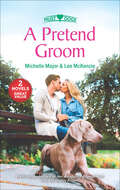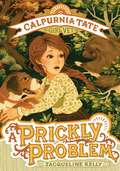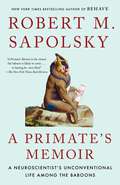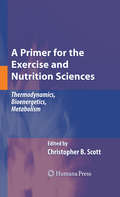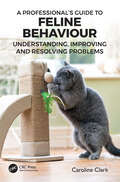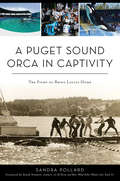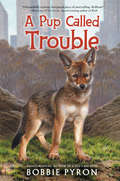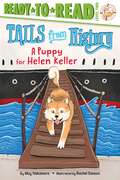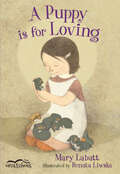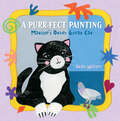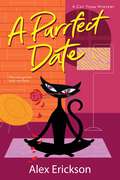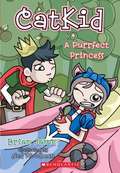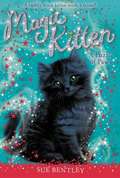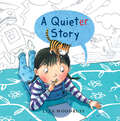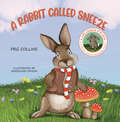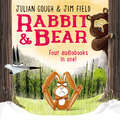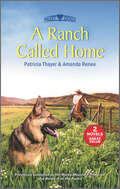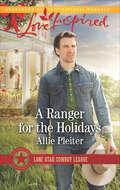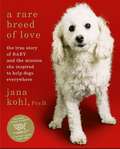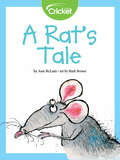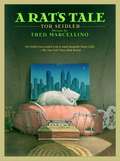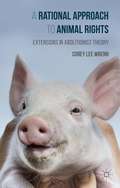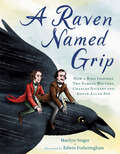- Table View
- List View
A Pretend Groom (Must Love Dogs)
by Michelle Major Lee McKenzieFind your Happily Ever After with two feel-good novels about dogs unleashing romance in small-town settings.Her Accidental Engagement by Michelle MajorIn the midst of a nasty custody battle, Julia Morgan needs to prove she can provide a stable environment for her son, Charlie. So when gorgeous police chief Sam Callahan agrees to help by pretending to be her fiancé, she gratefully accepts his fake proposal. The arrangement will also get Sam’s father off his back about finding “the one.” But what happens when pretend doesn’t seem so, well, pretend anymore?The Daddy Project by Lee McKenzieAs a busy single mom, Kristi Callahan doesn’t have time for a man. But her mother won’t believe it. She keeps setting Kristi up on disastrous blind dates. Widowed Nate McTavish has the same problem with his well-meaning family. When Nate hires Kristi to stage his house before selling it, they realize they’ve found the answer to their problems: be fake dates for each other! It’s a perfect plan . . .
A Prickly Problem: Calpurnia Tate, Girl Vet (Calpurnia Tate, Girl Vet #4)
by Jacqueline KellyIn this story in the Calpurnia Tate, Girl Vet chapter book series, Callie must help the family dog out of a prickly situation.When the Tate family dog, Ajax, has a run-in with a porcupine, things get prickly—and dangerous—quickly. It'll take Callie's quick thinking and doctoring, along with a little help from Dr. Pritzker, to make things right. Will Ajax learn to leave other critters alone?- GODWIN BOOKS -
A Primate's Memoir: A Neuroscientist's Unconventional Life Among the Baboons (Thorndike Press Large Print Adventure Ser.)
by Robert M. SapolskyIn the tradition of Jane Goodall and Dian Fossey, Robert Sapolsky, a foremost science writer and recipient of a MacArthur Genius Grant, tells the mesmerizing story of his twenty-one years in remote Kenya with a troop of savanna baboons."I had never planned to become a savanna baboon when I grew up; instead, I had always assumed I would become a mountain gorilla,&” writes Robert Sapolsky in this witty and riveting chronicle of a scientist&’s coming-of-age in Africa. An exhilarating account of Sapolsky&’s twenty-one-year study of a troop of rambunctious baboons in Kenya, A Primate&’s Memoir interweaves serious scientific observations with wry commentary about the challenges and pleasures of living in the wilds of the Serengeti—for man and beast alike. Over two decades, Sapolsky survives culinary atrocities, gunpoint encounters, and a surreal kidnapping, while witnessing the encroachment of the tourist mentality on Africa. As he conducts unprecedented physiological research on wild primates, he becomes enamored of his subjects—unique and compelling characters in their own right—and he returns to them summer after summer, until tragedy finally prevents him. By turns hilarious and poignant, A Primate&’s Memoir is a magnum opus from one of our foremost science writers.
A Primer for the Exercise and Nutrition Sciences: Thermodynamics, Bioenergetics, Metabolism
by Christopher B. ScottThe subject of thermodynamics is rarely found in Nutrition and Exercise Physiology textbooks. Yet this material is fundamental to any serious inquisition concerning energy exchange. This book provides a fresh approach to the study of energy expenditure by introducing the latest concepts in open system thermodynamics and cellular to whole-body energy exchange. The text traces biological energy exchange, from the molecules in the food we eat to the energy demands of rest, physical exertion and its recovery. The carefully researched text advances traditional exercise physiology concepts by incorporating contemporary thermodynamic and cellular physiology principles into the context of a 'working' metabolism. This book is written for upper level undergraduate and graduate students, but will also appeal to exercise physiologists, registered dieticians and nutritionists, and applies to cardiac rehabilitation, exercise science and health fitness programs.
A Professional’s Guide to Feline Behaviour: Understanding, Improving and Resolving Problems
by Caroline ClarkA Professional's Guide to Feline Behaviour is an invaluable resource for the feline professional, yet written in such an accessible way that it would be of interest to anyone who shares their life with a cat and wants to gain a deeper understanding of their behaviour.The book is presented in easy-to-navigate sections, each packed with practical advice and the colour illustrations, tables and graphics throughout make it approachable for every type of reader.What this guide offers: A greater understanding of cats and how to meet their needs. How to recognise and mitigate negative emotions and deal with challenges that cats face both at home and particularly in the workplace. How to analyse feline behaviour accurately, with a view to designing a tailored behaviour modification plan. Comprehensive information on common, and not so common, problematic feline behaviours. The fundamentals of learning theory, with step-by-step training guides. Real-life case studies, accompanied by behaviour plans that integrate clinically proven methods to help manage or resolve a range of behaviour issues. Written by Caroline Clark, a Registered Clinical Animal Behaviourist and RCVS listed veterinary nurse, this well-researched book draws from her knowledge and professional experiences, offering a unique insight into feline behaviour.
A Puget Sound Orca in Captivity: The Fight To Bring Lolita Home
by David Neiwert Sandra PollardOn August 8, 1970, the Southern Resident orcas of Puget Sound were herded into Penn Cove on Whidbey Island by explosives, spotter planes and speedboats in a coordinated effort to capture seven young whales. Between 1964 and 1976, dozens of these now-endangered orcas were torn from their home and sent to marine parks around the globe. Just over a decade later, all but one had died. This lone survivor is Tokitae, also known as Lolita, and she's spent most of her life performing at the Miami Seaquarium. For twenty years, the Orca Network has called for her release, and now the indigenous Lummi Nation, People of the Sea, have joined the fight. Author Sandra Pollard chronicles the extraordinary effort to bring Tokitae home.
A Pup Called Trouble
by Bobbie PyronFans of classic animal stories like Pax and A Dog’s Way Home will howl over the heartwarming adventures of a coyote pup lost in New York City. Brimming with curiosity, Trouble can’t wait to explore the world beyond Singing Creek. So one morning the coyote pup stows away in the back of a truck and ends up lost in the heart of New York City. While Trouble misses his siblings, he quickly makes friends in Central Park’s Ramble: a prankster crow, a timid opossum, and a poetic poodle. Before long, he goes from howling for home to wondering if he could make a life in the city forever. But when word gets out that a coyote is running wild on city streets, Trouble must choose between the risks of being caught and the dangers of a long journey home. Inspired by true stories, this accessible read from the award-winning author of A Dog’s Way Home will resonate with anyone who’s ever felt torn between the longing for adventure and the call of home. An appendix with real accounts of wild animals trapped in the city adds to the fun!
A Pup in King Arthur's Court (The Adventures of Wishbone)
by Joanne BarkanFrom the Book Jacket: Using a computer, Joe Talbot and David Barnes decide to publish a sports newsletter that will put the school's existing one to shame. New technology over old ideas? This reminds Wishbone of Mark Twain's hilarious classic tale, A Connecticut Yankee in King Arthur's Court. Wishbone imagines himself as Hank Morgan, an inventor who is transported back in time to King Arthur's court at Camelot. As Morgan, Wishbone immediately decides to use his Yankee know-how to modernize the simple medieval society. With knights on bicycles, jousting with lassos, and a sixth-century stock market, he causes quite a stir old England. Morgan also makes an enemy out of a powerful wizard named Merlin, who liked things just the way they were!
A Puppy for Helen Keller: Ready-to-read Level 2 (Tails From History)
by May NakamuraHelen Keller inspired people all around the world, but what inspired her? She was enchanted by the loyal Akita dogs from Japan. The Japanese people wanted to give Helen an Akita, but trouble was brewing between Japan and the United States. Would the puppy arrive safely? Pictures are described. Reading age, 6-8
A Puppy is for Loving (Orca Echoes)
by Mary LabattElsie is about to have puppies, and Elizabeth is going to help. Her grandmother shows her exactly how to make the den for the dog and how to be ready when the puppies come out. After they are born, Elizabeth helps Elsie care for them. Most important of all, though, she helps her grandmother find just the right home for each, especially the very last one.
A Purr-fect Painting: Matisse's Other Great Cat (Artists and Their Animals)
by Joan WaitesDiscover the world of Henri Matisse through the eyes of his cat, La Puce. Join him and his two companions, Minouche and Coussi, as they spend their days in Matisse's sunny seaside apartment watching the artist create his paintings. As La Puce observes Matisse painting his masterpiece The Cat with the Red Fish, featuring Minouche, he too longs to be the subject of one of his paintings. After Matisse falls ill and can no longer paint standing up, La Puce tries to coax him back into painting by using himself as a model. When an accident happens, La Puce inspires the artist to create again . . . but this time using paper and scissors!
A Purrfect Date (A Cat Yoga Mystery)
by Alex EricksonUp-and-comer Ashley Branson usually aims to keep both feet placed firmly on the ground—unless she&’s instructing a class at her trendy cat yoga studio. But she soon finds herself caught in a downward spiral when a stretch beyond her comfort zone leads to murder . . .Ashley Branson is sure of one thing after experiencing a disastrous blind date—she would much rather enjoy the single life and hang out with playful felines at her studio, A Purrfect Pose, than ever compromise her inner peace like that again. When the mysterious guy makes a late arrival then has the nerve to dine and dash, it&’s embarrassing. But when he winds up dead in his apartment that same night? Ash suddenly finds herself thrust into a twisted murder investigation and questioning if she might be shaping up to be the suspect . . . or the next victim.Ash races to claw through a web of lies, hidden identities, and love lives even more complicated than her own to uncover the truth. Adding to the chaos, she believes her shifty neighbor—covered in unexplained injuries and rumored to harbor a crush on her—could be connected to the crime. Now, with more leads than she needs, Ash must take a deep breath, pull on her big-girl leggings, and move faster than the cunning killer who wants to put her in corpse pose for good . . .
A Purrfect Princess (CatKid)
by Brian JamesCatKid is at it again! Spunk and personality make CatKid a natural performer, and she's the star in the class production of Snow White. Pretending to be in a deep sleep should be the hard part, but that's nothing compared to having to act like Billy the Bully is Prince Charming. Billy a Prince? That's not typecasting at all! The worst part is the dreaded kiss. CatKid is determined to find a way out of it, but will she have to forfeit the spotlight? Or will our star live happily every after?
A Puzzle of Paws #12
by Andrew Farley Sue Bentley Angela SwanRosie is devastated when her parents tell her that when they move to their new, smaller house, there won't be any room for her pets. She's going to have to find new homes for them all! Then Rosie discovers cuddly black kitten Flame, and suddenly moving day doesn't seem so bad after all.
A Quieter Story
by Liza WoodruffA kitten insists that his little-girl owner write an adventure story suitable for a TIGER and learns that you should be careful about what you wish for when the story becomes too scary.When a little girl starts to write a story about her kitten playing with yarn, he doesn't like it one bit. He wants a story for his alter-ego TIGER--one that has pep and pizzazz--so the girl creates an adventure that the kitten jumps into. Darkness surrounds him (No light, no problem! says the kitten), venomous vipers drop from the trees (Snakes? I've got this), hungry hyenas circle the tiger--and suddenly the kitten begins to wonder if there can be such a thing as too much adventure. As the story gets scarier and scarier, he realizes that what one wants and what one needs are sometimes two different things. This time, he needs a quieter story.A colorful and inventive picture book about a creative girl and her kitten.
A Rabbit Called Sneeze
by Prg CollinsA young rabbit called Sneeze experienced an emotion called ‘fear’ when some hunters fired their guns near his home. His parents realised that he hadn’t felt scared like that ever before, so they spoke to him quietly and warmly, and told him how to handle fear. We will all feel scared some time in our lives, scared for ourselves or for our family and friends, so it’s something we should all know how to handle and to know what the safest thing to do about it might be when it happens.
A Rabbit and Bear Audio Omnibus: Four audiobooks in one! (Rabbit and Bear #999)
by Julian GoughA bumper audio edition including all four Rabbit and Bear books! This brilliantly funny collection brings Rabbit and his friend Bear to audio for the very first time: tales of friendship, gravity, and just a little bit of poo. 'A perfect animal double-act.' The Times, Book of the WeekIn Rabbit's Bad Habits, Bear wakes up early and decides to make a snowman. Rabbit wants to build an even better one. But with an avalanche and a hungry wolf heading his way, Rabbit realises having a friend might not be so bad after all.In The Pest in the Nest, Rabbit decides Something Simply Has To Be Done about Bear's snoring and Woodpecker's BANG!BANG!BANG! noise from up in the tree. But perhaps Bear can show Rabbit how to see the world differently.In Attack of the Snack, a Mysterious Thing lands in Rabbit and Bear's peaceful summer lake. And when Rabbit accidentally turns the Best Day Ever into the Worst Day Ever, only his friend Bear can help him turn the day around.In A Bite in the Night, even Bear is surprised: the trees seem to be flying south for the winter. There's a new creature in Rabbit and Bear's valley, and he's trying to Change Everything ... This audio omnibus is perfect for bedtime, or long journeys! Narrated by actor, writer and director Colleen Prendergast.(P)2019 Hodder & Stoughton Limited
A Rabbit for Easter
by Carol Carrick[from the book jacket] "Paul, of Paul's Christmas Birthday, is the happiest boy in kindergarten because he can take Sam, the class's pet rabbit, home during Easter vacation. Sam gets lost--and luckily, found. And a much wiser Paul has learned a valuable lesson. Another warmly satisfying picture book by the popular husband and wife team."
A Ranch Called Home (Must Love Dogs)
by Patricia Thayer Amanda ReneeSurvival instinctsHer Rocky Mountain Protector by Patricia ThayerWith his military dog in tow, ex-soldier Grady Fletcher plans to keep his troubled mind occupied while staying on his grandfather’s property—until it’s time to move on again. Single mom Gina Williams gets the distinct feeling that beneath Grady’s guarded exterior lies a kind, trustworthy man. So when Gina’s little boy goes missing, there’s only one person she’ll turn to for help…Blame It on the Rodeo by Amanda ReneeWorking at the Langtry family’s ranch forces veterinarian Lexi Lawson to confront rodeo rider Shane Langtry, the man who broke her heart. Long ago, when they were in love, Lexi hid a terrible secret from Shane—one she planned to keep forever. But when he learns the truth, she’s forced to choose between the past she left behind…and the future they might still find together.
A Ranger for the Holidays (Lone Star Cowboy League #3)
by Allie PleiterThis lawman is praying for a Christmas to remember. Third in the series of bighearted ranchers in small-town Texas, following A Doctor for the Nanny.In Little Horn, Texas, Amelia Klondike is known as the Queen of Christmas. Her generosity and sheer joy during the holidays is contagious—to everyone except Finn Brannigan. The attractive, wounded stranger doesn’t know who he is or where he came from—and he isn’t feeling merry at all.It isn’t long before Amelia, her grandfather and their adorable dog begin to warm Finn’s heart. But when Finn’s memory starts to return, his past as a Texas Ranger—the one thing that might cause Amelia to withdraw from him—is revealed. And he worries that he may lose his chance for one perfect Western Christmas with the woman he can’t bear to forget . . .
A Rare Breed of Love: The True Story of Baby and the Mission She Inspired to Help Dogs Everywhere
by Jana KohlThis true story chronicles the travels of Baby, a three-legged poodle rescued from a puppy mill, who, along with her human, Kohl, aim to raise awareness and help stop animal cruelty.
A Rat's Tale
by Ann McLainRats are opportunistic, living in human cities provides them with food, shelter, and everything else they need!
A Rat's Tale
by Tor SeidlerAlthough young Montague Mad-Rat lives in, or rather, under, New York City, he knows very few rats besides his mother, who makes hats, his father, who builds mud castles, and his globe-trotting Aunt Elizabeth. But Montague's life takes an abrupt turn on the eventful stormy day he meets Isabel Moberly-Rat on his way home from Central Park. Home, for Montague, is an old sewer pipe. He now learns that there is a city full of other rats out there who inhabit abandoned piers and lead considerably less eccentric and more luxurious lives than his family.
A Rational Approach to Animal Rights: Extensions in Abolitionist Theory
by Corey Lee WrennA Rational Approach to Animal Rights.
A Raven Named Grip: How a Bird Inspired Two Famous Writers, Charles Dickens and Edgar Allan Poe
by Marilyn SingerThe endearing true story of how a love of birds connected and inspired two literary giants--Charles Dickens and Edgar Allan Poe.Years before Edgar Allan Poe's raven said "Nevermore," Charles Dickens' pet raven, Grip, was busy terrorizing the Dickens children and eating chipped paint. So how exactly did this one mischievous bird make a lasting mark on literature? From England to the United States and back again, this is the true and fascinating story of how a brilliant bird captured two famous authors' hearts, inspired their writing, and formed an unexpected bond between them. This ingenious slice of history, biography, and even ornithology celebrates the fact that creative inspiration can be found everywhere.
